By Dick Moeller
Today we depart the hotel in Gondar for the airport at a “normal” time, around 7:00 am, headed for Lalibela. It is a short flight from Gondar to Lalibela, so we are at our hotel in Lalibella by 10:00 am.
The town of Lalibela was originally known as Roha. It was renamed after the 12th-century King Lalibela, who commissioned the creation of these extraordinary churches. King Lalibela was a member of the Zagwe dynasty in Ethiopia, which had seized the throne around 1000 AD. When his rivals began to increase in power and strength, Lalibela sought the favor and support of the powerful Ethiopian Christian Orthodox Church by building the churches in this small town. His goal was to create the New Jerusalem for those who could not make a pilgrimage to the Holy Land. Of Lalibela’s 30,00 people, over 1,000 are priests.
Our group will diverge again today, with most of the travelers visiting the rock churches. Dick and Jim, having seen the churches numerous times before, opt for a mule ride to the top of the mountain to see Ashete Mariam Monastery.
The churches…..
The 11 churches were fashioned out of the stone over a period of 23 years. Obviously, it was a massive undertaking involving thousands of stone masons, stone cutters and workers removing the chipped stone.
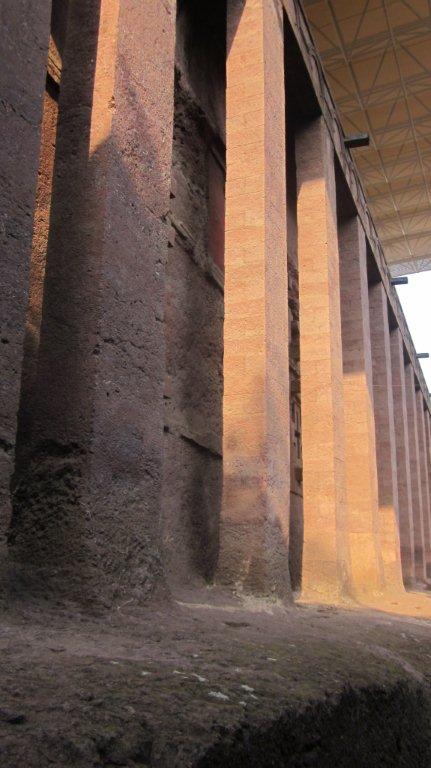
The first church we visited is the largest, the Church of our Savior. The roof of the church, also carved out of the stone, is supported by 72 columns of stone, both inside and outside the church itself. Each of the churches is structured in the traditional way, with a nave for worshippers, and a sanctuary that houses a replica of the Arc of the Covenant, where only the priests may enter.
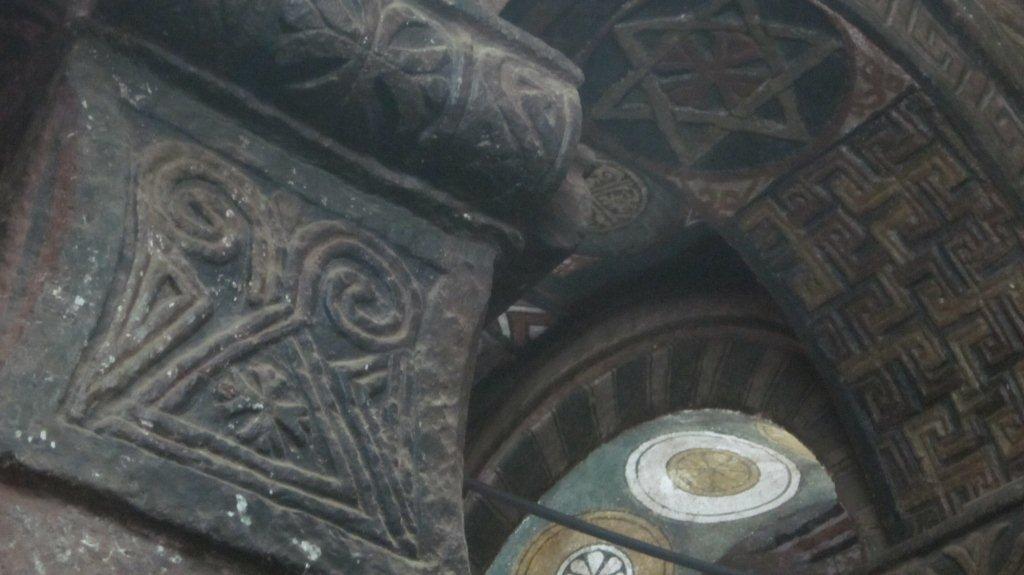
The inside of each of the churches is decorated with elaborate carvings and artwork that depict various scenes from both the Old and New Testament, as well as traditional Ethiopian Orthodox writings.
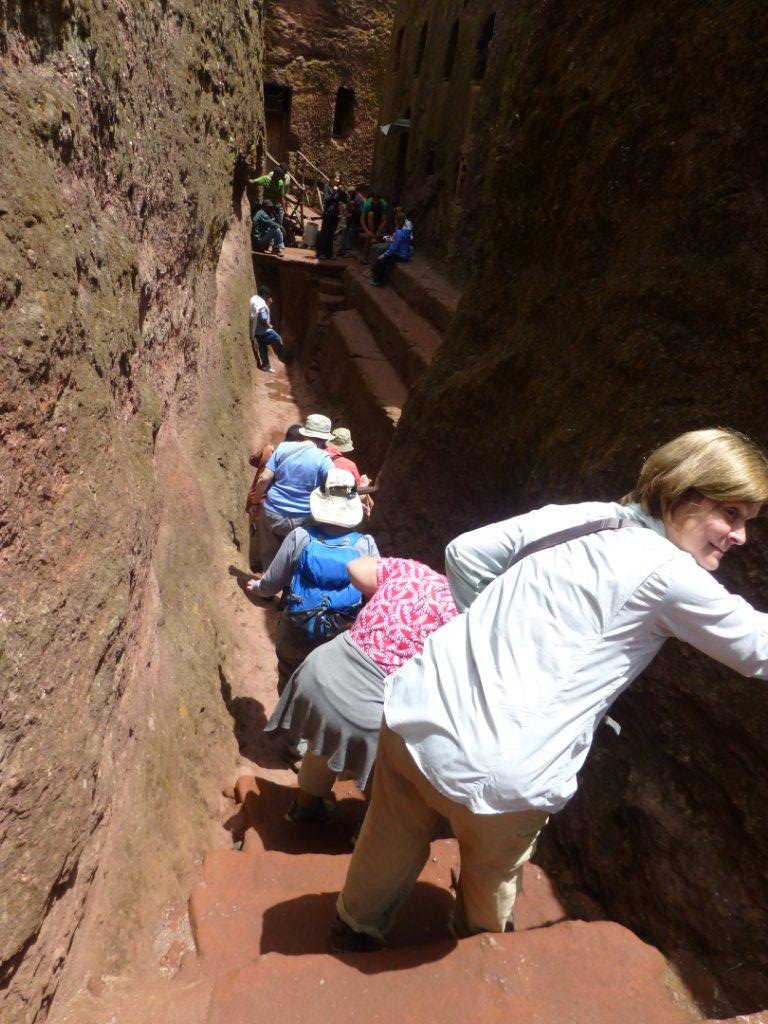
The first 5 churches that we visited are located in a cluster, each connected to the other by narrow, and sometimes treacherous, walkway hewed out of the granite. These walkways also serve an effective drainage system to move water away from the churches when it rains.
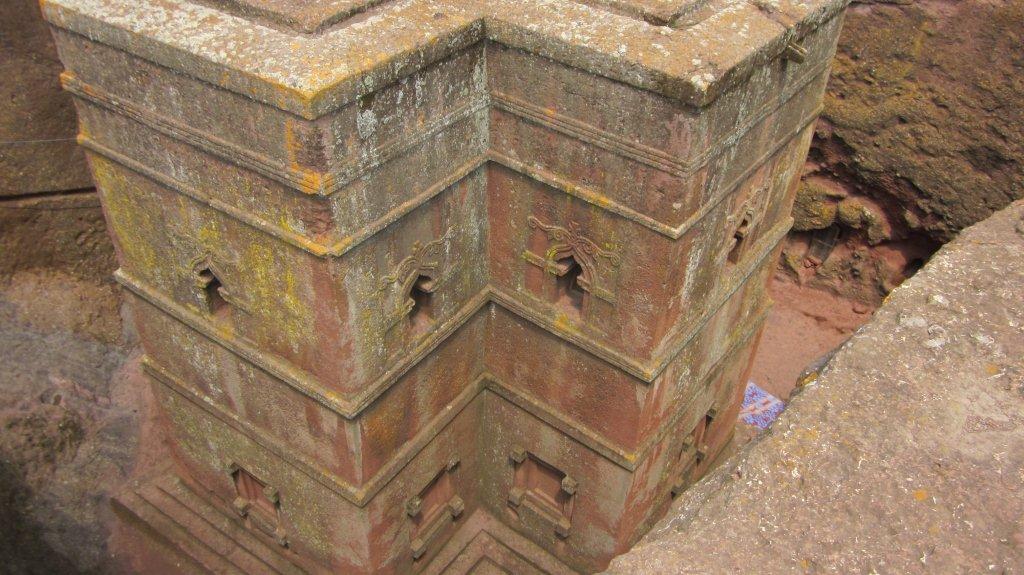
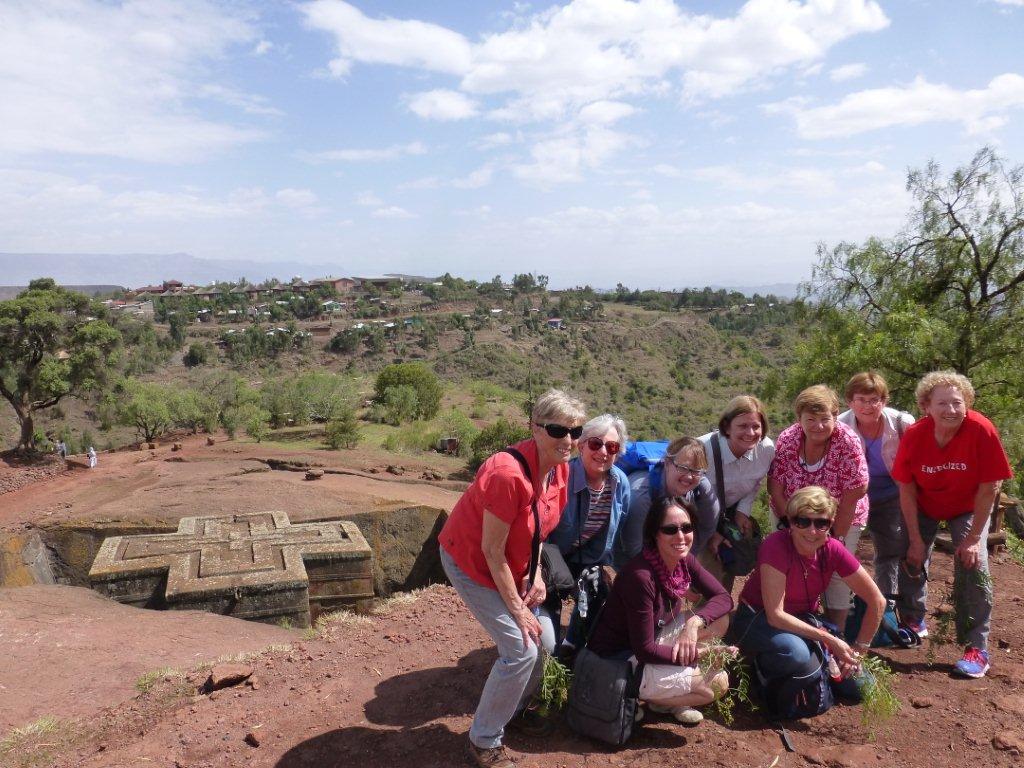
One of the most distinctive and famous of the churches is St. George’s, shown above. It was carved in the shape of a cross. It is unique in its design as it is supported entirely by the outer walls of the church with no pillars either inside or out.
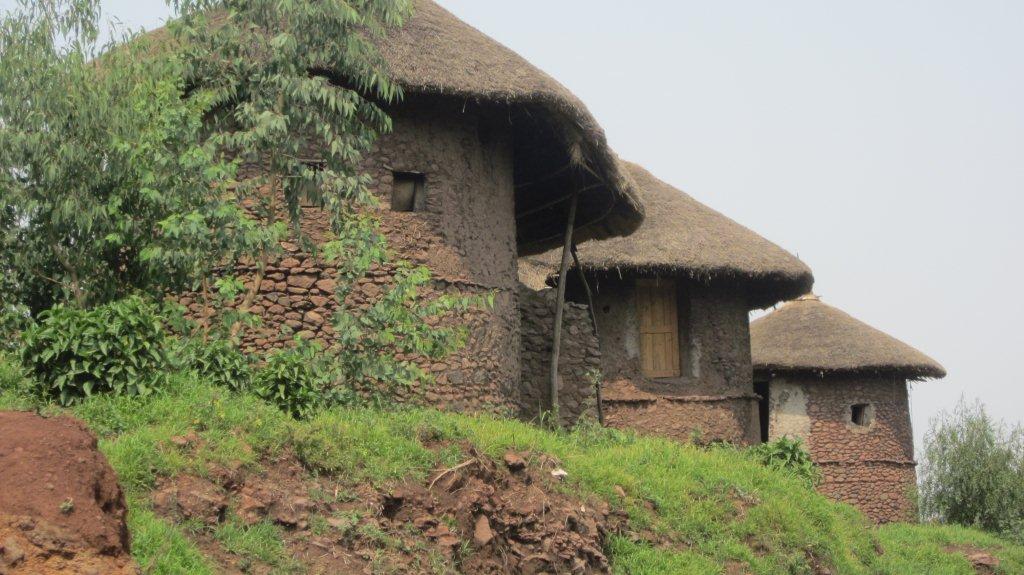
Around the village of Lalibela, you can still see the traditional tukul homes. These homes have a unique round design, with a thatched roof. Typically, they are two stories, with the family living on the upper level and animals are housed at night on the lower level.
The mule ride…….
Jim and Dick set off for the mule ride about 1:00 pm, right from the hotel. They will ascend over 3,000 feet up a very narrow, and most of the time treacherous pathway.
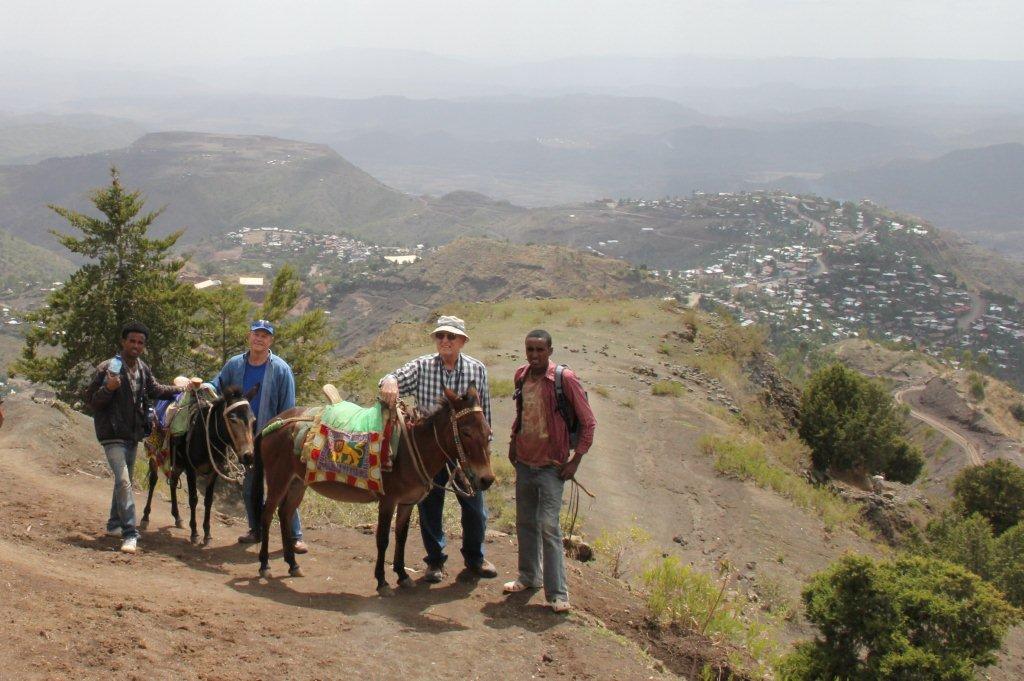
The mules are very cleaver in navigating the narrow pathways, and are certainly not afraid of heights! We think they intentionally try to scare the “Americanas Turistas” species by walking oh so every close to the edge every now and then.
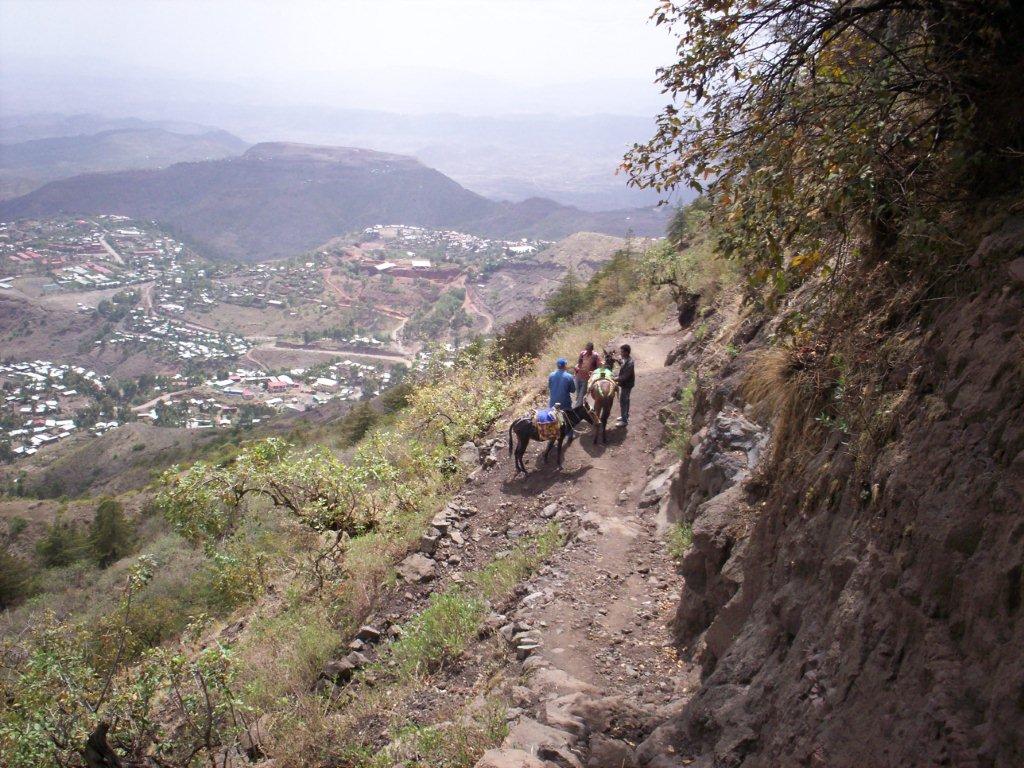
The picture above shows a “good” part of the trail. Sometimes the trails are so narrow, there is only room for one mule to walk. After about an hour on the mule, we have to get off to walk, because it is too steep for the mule to safely carry us. After about 15 minutes of climbing what felt like straight up the cliff, we decided we had seen enough! The vistas are beautiful, but, well, not that beautiful in hindsight!
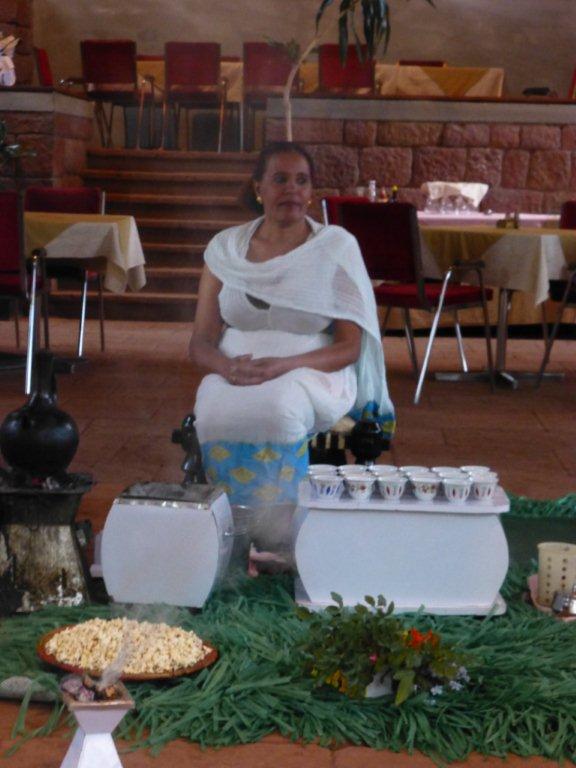
This evening after dinner, we were treated to a local authentic coffee ceremony. The coffee ceremony is at the heart of one of the most traditional social settings in Ethiopian homes. It will often take 1 to 1 ½ hours, giving plenty of time for fellowship. The steps involve roasting and grinding the fresh coffee beans and the same ground coffee is boiled three times, producing a rich, deep flavor, and then served to the guests.
By Dick Moeller
Today we depart the hotel in Gondar for the airport at a “normal” time, around 7:00 am, headed for Lalibela. It is a short flight from Gondar to Lalibela, so we are at our hotel in Lalibella by 10:00 am.
The town of Lalibela was originally known as Roha. It was renamed after the 12th-century King Lalibela, who commissioned the creation of these extraordinary churches. King Lalibela was a member of the Zagwe dynasty in Ethiopia, which had seized the throne around 1000 AD. When his rivals began to increase in power and strength, Lalibela sought the favor and support of the powerful Ethiopian Christian Orthodox Church by building the churches in this small town. His goal was to create the New Jerusalem for those who could not make a pilgrimage to the Holy Land. Of Lalibela’s 30,00 people, over 1,000 are priests.
Our group will diverge again today, with most of the travelers visiting the rock churches. Dick and Jim, having seen the churches numerous times before, opt for a mule ride to the top of the mountain to see Ashete Mariam Monastery.
The churches…..
The 11 churches were fashioned out of the stone over a period of 23 years. Obviously, it was a massive undertaking involving thousands of stone masons, stone cutters and workers removing the chipped stone.

The first church we visited is the largest, the Church of our Savior. The roof of the church, also carved out of the stone, is supported by 72 columns of stone, both inside and outside the church itself. Each of the churches is structured in the traditional way, with a nave for worshippers, and a sanctuary that houses a replica of the Arc of the Covenant, where only the priests may enter.

The inside of each of the churches is decorated with elaborate carvings and artwork that depict various scenes from both the Old and New Testament, as well as traditional Ethiopian Orthodox writings.

The first 5 churches that we visited are located in a cluster, each connected to the other by narrow, and sometimes treacherous, walkway hewed out of the granite. These walkways also serve an effective drainage system to move water away from the churches when it rains.


One of the most distinctive and famous of the churches is St. George’s, shown above. It was carved in the shape of a cross. It is unique in its design as it is supported entirely by the outer walls of the church with no pillars either inside or out.

Around the village of Lalibela, you can still see the traditional tukul homes. These homes have a unique round design, with a thatched roof. Typically, they are two stories, with the family living on the upper level and animals are housed at night on the lower level.
The mule ride…….
Jim and Dick set off for the mule ride about 1:00 pm, right from the hotel. They will ascend over 3,000 feet up a very narrow, and most of the time treacherous pathway.

The mules are very cleaver in navigating the narrow pathways, and are certainly not afraid of heights! We think they intentionally try to scare the “Americanas Turistas” species by walking oh so every close to the edge every now and then.

The picture above shows a “good” part of the trail. Sometimes the trails are so narrow, there is only room for one mule to walk. After about an hour on the mule, we have to get off to walk, because it is too steep for the mule to safely carry us. After about 15 minutes of climbing what felt like straight up the cliff, we decided we had seen enough! The vistas are beautiful, but, well, not that beautiful in hindsight!

This evening after dinner, we were treated to a local authentic coffee ceremony. The coffee ceremony is at the heart of one of the most traditional social settings in Ethiopian homes. It will often take 1 to 1 ½ hours, giving plenty of time for fellowship. The steps involve roasting and grinding the fresh coffee beans and the same ground coffee is boiled three times, producing a rich, deep flavor, and then served to the guests.

About The Author: Meredith
More posts by Meredith